Abstract
It is generally accepted that the type A behaviour pattern is a risk factor in the development of coronary artery disease (CAD). Type A people have been characterized as hard-driving, competitive, aggressive and hurried. A number of investigators have attempted to correlate these facets of type A behaviour with increased risks of CAD. However, there have been conflicting results, primarily owing to differences in methods and CAD outcomes and inconsistencies associated with measuring the type A behaviour pattern. As a result, researchers have begun to focus on subcomponents of the type A behaviour pattern, particularly hostility and anger, that appear to be more reliable predictors of CAD outcome. A reconceptualization of the type A behaviour pattern is required.
Full text
PDF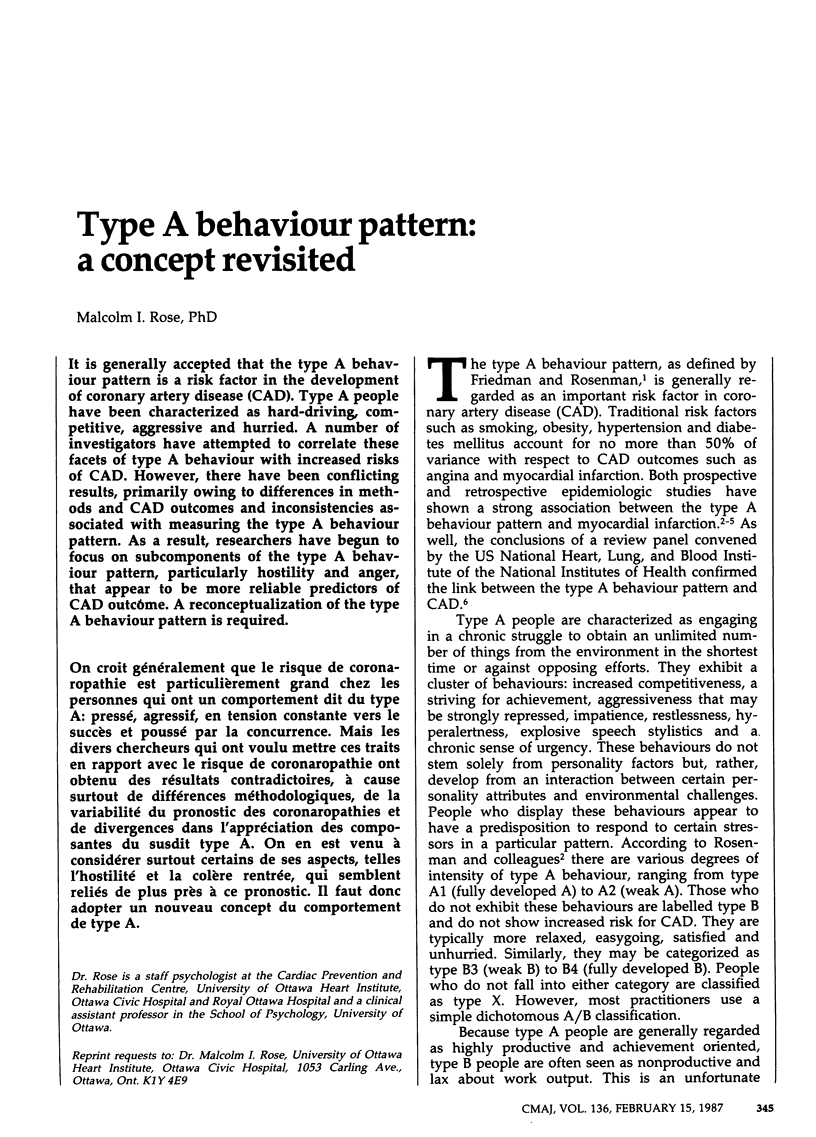
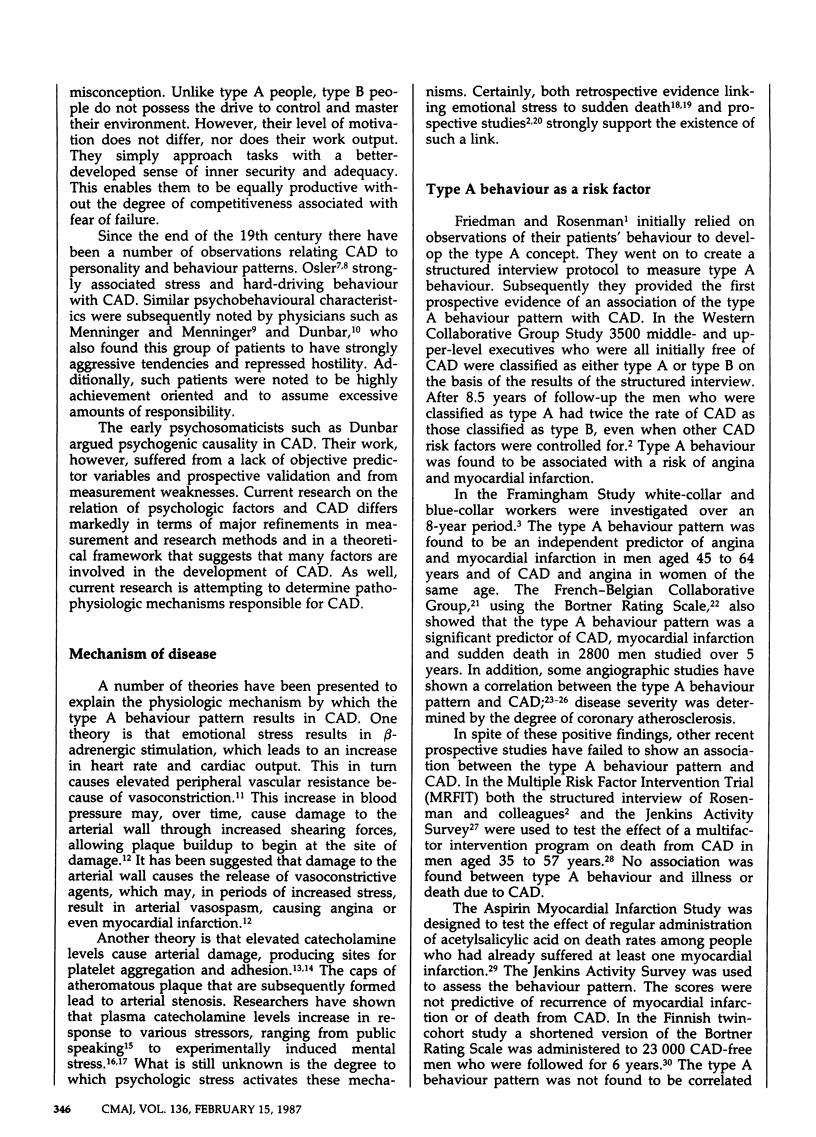
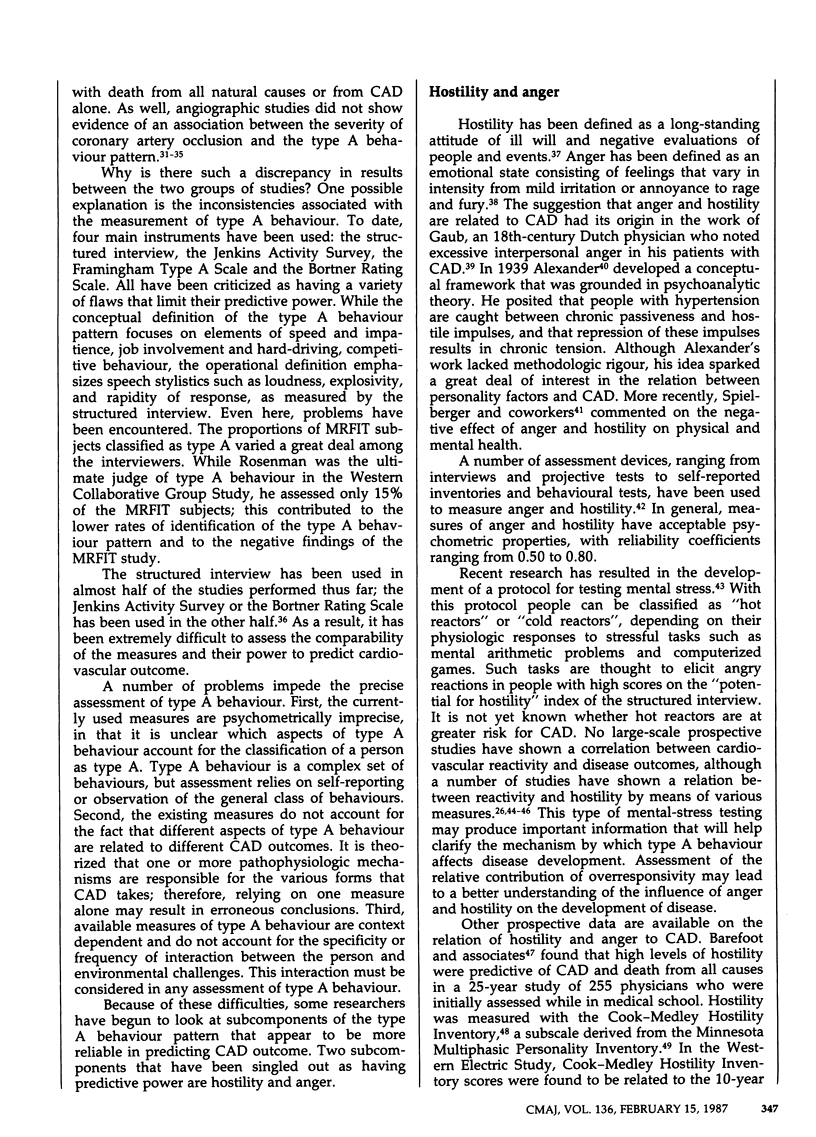
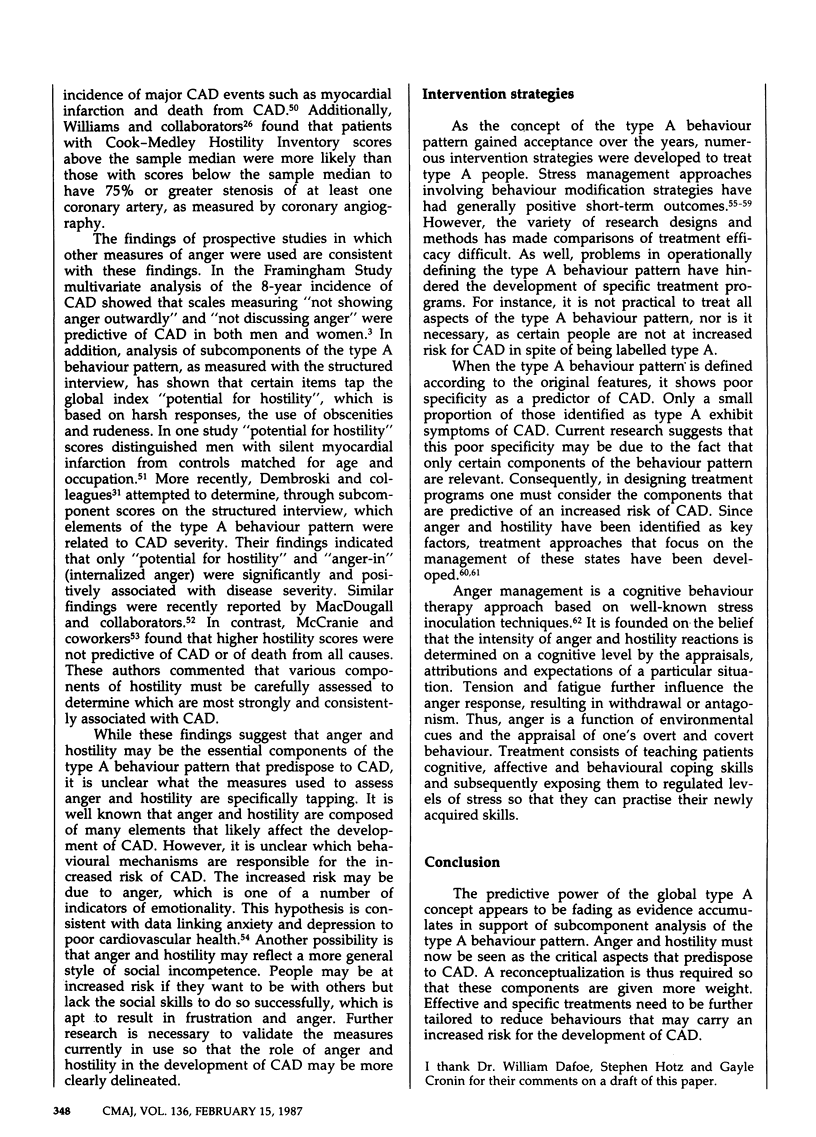
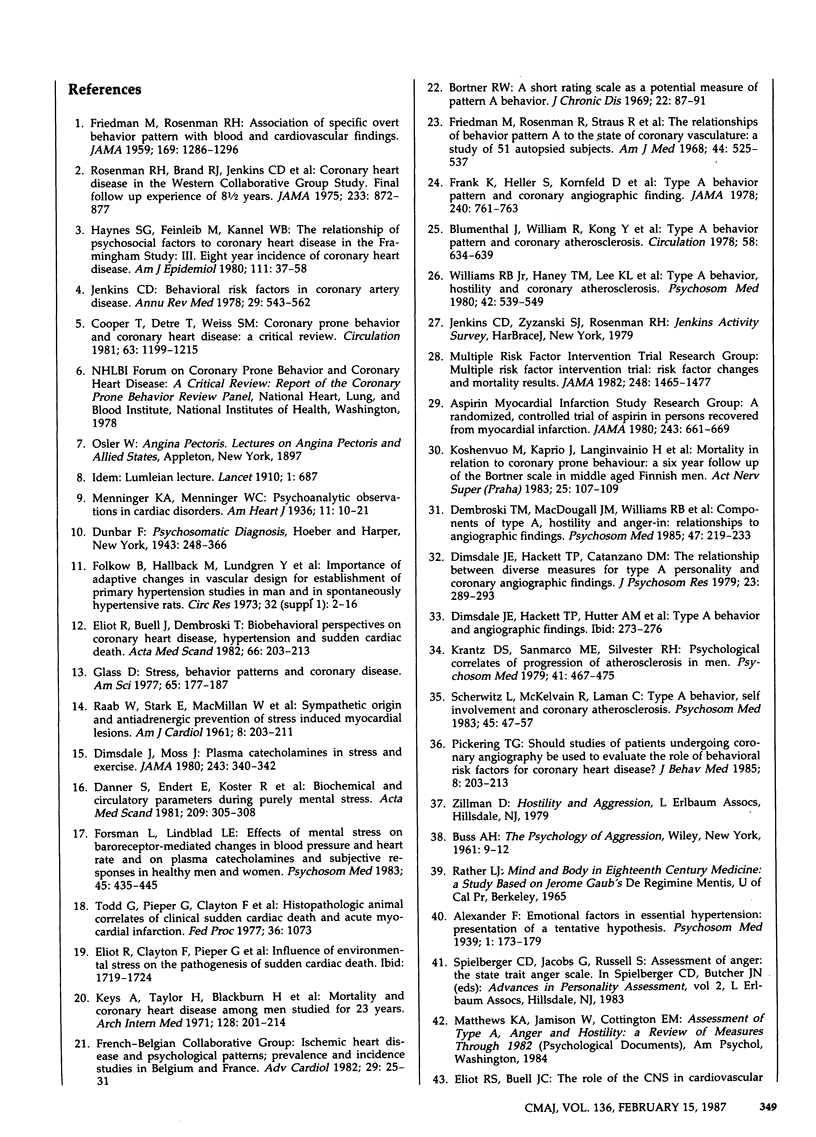
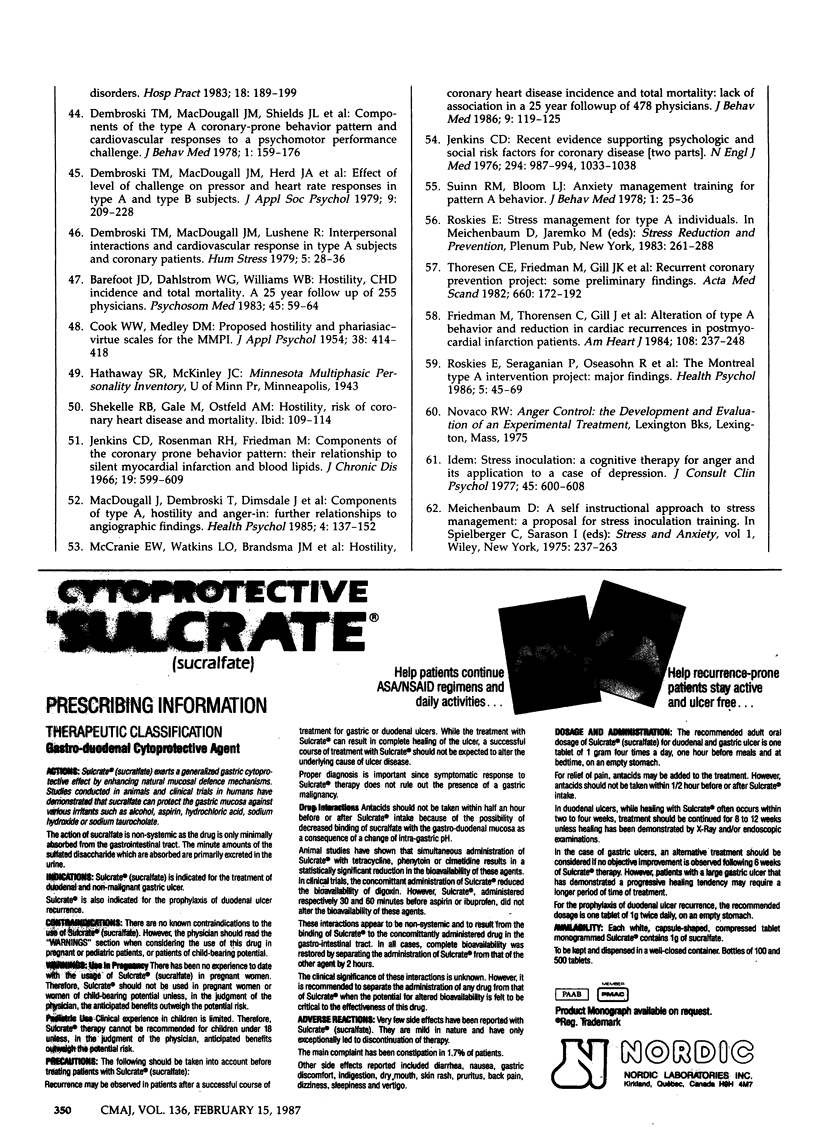
Selected References
These references are in PubMed. This may not be the complete list of references from this article.
- Barefoot J. C., Dahlstrom W. G., Williams R. B., Jr Hostility, CHD incidence, and total mortality: a 25-year follow-up study of 255 physicians. Psychosom Med. 1983 Mar;45(1):59–63. doi: 10.1097/00006842-198303000-00008. [DOI] [PubMed] [Google Scholar]
- Blumenthal J. A., Williams R. B., Jr, Kong Y., Schanberg S. M., Thompson L. W. Type A behavior pattern and coronary atherosclerosis. Circulation. 1978 Oct;58(4):634–639. doi: 10.1161/01.cir.58.4.634. [DOI] [PubMed] [Google Scholar]
- Bortner R. W. A short rating scale as a potential measure of pattern A behavior. J Chronic Dis. 1969 Jul;22(2):87–91. doi: 10.1016/0021-9681(69)90061-7. [DOI] [PubMed] [Google Scholar]
- Coronary-prone behavior and coronary heart disease: a critical review. The review panel on coronary-prone behavior and coronary heart disease. Circulation. 1981 Jun;63(6):1199–1215. doi: 10.1161/01.cir.63.6.1199. [DOI] [PubMed] [Google Scholar]
- Danner S. A., Endert E., Koster R. W., Dunning A. J. Biochemical and circulatory parameters during purely mental stress. Acta Med Scand. 1981;209(4):305–308. doi: 10.1111/j.0954-6820.1981.tb11596.x. [DOI] [PubMed] [Google Scholar]
- Dembroski T. M., MacDougall J. M., Lushene R. Interpersonal interaction and cardiovascular response in type A subjects and coronary patients. J Human Stress. 1979 Dec;5(4):28–36. doi: 10.1080/0097840x.1979.10545992. [DOI] [PubMed] [Google Scholar]
- Dembroski T. M., MacDougall J. M., Shields J. L., Petitto J., Lushene R. Components of the type A coronary-prone behavior pattern and cardiovascular responses to psychomotor performance challenge. J Behav Med. 1978 Jun;1(2):159–176. doi: 10.1007/BF00846637. [DOI] [PubMed] [Google Scholar]
- Dembroski T. M., MacDougall J. M., Williams R. B., Haney T. L., Blumenthal J. A. Components of Type A, hostility, and anger-in: relationship to angiographic findings. Psychosom Med. 1985 May-Jun;47(3):219–233. doi: 10.1097/00006842-198505000-00001. [DOI] [PubMed] [Google Scholar]
- Dimsdale J. E., Hackett T. P., Catanzano D. M., White P. J. The relationship between diverse measures for Type A personality and coronary angiographic findings. J Psychosom Res. 1979;23(5):289–293. doi: 10.1016/0022-3999(79)90033-3. [DOI] [PubMed] [Google Scholar]
- Dimsdale J. E., Moss J. Plasma catecholamines in stress and exercise. JAMA. 1980 Jan 25;243(4):340–342. [PubMed] [Google Scholar]
- Eliot R. S., Buell J. C., Dembroski T. M. Bio-behavioural perspectives on coronary heart disease, hypertension and sudden cardiac death. Acta Med Scand Suppl. 1982;660:203–213. doi: 10.1111/j.0954-6820.1982.tb00375.x. [DOI] [PubMed] [Google Scholar]
- FRIEDMAN M., ROSENMAN R. H. Association of specific overt behavior pattern with blood and cardiovascular findings; blood cholesterol level, blood clotting time, incidence of arcus senilis, and clinical coronary artery disease. J Am Med Assoc. 1959 Mar 21;169(12):1286–1296. doi: 10.1001/jama.1959.03000290012005. [DOI] [PubMed] [Google Scholar]
- Folkow B., Hallbäck M., Lundgren Y., Sivertsson R., Weiss L. Importance of adaptive changes in vascular design for establishment of primary hypertension, studied in man and in spontaneously hypertensive rats. Circ Res. 1973 May 5;32(Suppl):2–16. doi: 10.1007/978-3-642-65441-1_23. [DOI] [PubMed] [Google Scholar]
- Forsman L., Lindblad L. E. Effect of mental stress on baroreceptor-mediated changes in blood pressure and heart rate and on plasma catecholamines and subjective responses in healthy men and women. Psychosom Med. 1983 Oct;45(5):435–445. doi: 10.1097/00006842-198310000-00007. [DOI] [PubMed] [Google Scholar]
- Frank K. A., Heller S. S., Kornfeld D. S., Sporn A. A., Weiss M. B. Type A behavior pattern and coronary angiographic findings. JAMA. 1978 Aug 25;240(8):761–763. [PubMed] [Google Scholar]
- Friedman M., Rosenman R. H., Straus R., Wurm M., Kositchek R. The relationship of behavior pattern A to the state of the coronary vasculature. A study of fifty-one autopsy subjects. Am J Med. 1968 Apr;44(4):525–537. doi: 10.1016/0002-9343(68)90053-3. [DOI] [PubMed] [Google Scholar]
- Friedman M., Thoresen C. E., Gill J. J., Powell L. H., Ulmer D., Thompson L., Price V. A., Rabin D. D., Breall W. S., Dixon T. Alteration of type A behavior and reduction in cardiac recurrences in postmyocardial infarction patients. Am Heart J. 1984 Aug;108(2):237–248. doi: 10.1016/0002-8703(84)90606-9. [DOI] [PubMed] [Google Scholar]
- Glass D. C. Stress, behavior patterns, and coronary disease. Am Sci. 1977 Mar-Apr;65(2):177–187. [PubMed] [Google Scholar]
- Haynes S. G., Feinleib M., Kannel W. B. The relationship of psychosocial factors to coronary heart disease in the Framingham Study. III. Eight-year incidence of coronary heart disease. Am J Epidemiol. 1980 Jan;111(1):37–58. doi: 10.1093/oxfordjournals.aje.a112873. [DOI] [PubMed] [Google Scholar]
- Jenkins C. D. Behavioral risk factors in coronary artery disease. Annu Rev Med. 1978;29:543–562. doi: 10.1146/annurev.me.29.020178.002551. [DOI] [PubMed] [Google Scholar]
- Jenkins C. D. Components of the coronary-prone behavior pattern. Their relation to silent myocardial infarction and blood lipids. J Chronic Dis. 1966 May;19(5):599–609. doi: 10.1016/0021-9681(66)90097-x. [DOI] [PubMed] [Google Scholar]
- Jenkins C. D. Medical progress. Recent evidence supporting psychologic and social risk factors for coronary disease (first of two parts). N Engl J Med. 1976 Apr 29;294(18):987–994. doi: 10.1056/NEJM197604292941806. [DOI] [PubMed] [Google Scholar]
- Keys A., Taylor H. L., Blackburn H., Brozek J., Anderson J. T., Simonson E. Mortality and coronary heart disease among men studied for 23 years. Arch Intern Med. 1971 Aug;128(2):201–214. doi: 10.1001/archinte.1971.00310200037002. [DOI] [PubMed] [Google Scholar]
- Krantz D. S., Sanmarco M. I., Selvester R. H., Matthews K. A. Psychological correlates of progression of atherosclerosis in men. Psychosom Med. 1979 Oct;41(6):467–475. doi: 10.1097/00006842-197910000-00003. [DOI] [PubMed] [Google Scholar]
- MacDougall J. M., Dembroski T. M., Dimsdale J. E., Hackett T. P. Components of type A, hostility, and anger-in: further relationships to angiographic findings. Health Psychol. 1985;4(2):137–152. doi: 10.1037//0278-6133.4.2.137. [DOI] [PubMed] [Google Scholar]
- McCranie E. W., Watkins L. O., Brandsma J. M., Sisson B. D. Hostility, coronary heart disease (CHD) incidence, and total mortality: lack of association in a 25-year follow-up study of 478 physicians. J Behav Med. 1986 Apr;9(2):119–125. doi: 10.1007/BF00848472. [DOI] [PubMed] [Google Scholar]
- Pickering T. G. Should studies of patients undergoing coronary angiography be used to evaluate the role of behavioral risk factors for coronary heart disease? J Behav Med. 1985 Sep;8(3):203–213. doi: 10.1007/BF00870308. [DOI] [PubMed] [Google Scholar]
- RAAB W., STARK E., MACMILLAN W. H., GIGEE W. R. Sympathogenic origin and antiadrenergic prevention of stress-induced myocardial lesions. Am J Cardiol. 1961 Aug;8:203–211. doi: 10.1016/0002-9149(61)90207-7. [DOI] [PubMed] [Google Scholar]
- Rosenman R. H., Brand R. J., Jenkins D., Friedman M., Straus R., Wurm M. Coronary heart disease in Western Collaborative Group Study. Final follow-up experience of 8 1/2 years. JAMA. 1975 Aug 25;233(8):872–877. [PubMed] [Google Scholar]
- Roskies E., Seraganian P., Oseasohn R., Hanley J. A., Collu R., Martin N., Smilga C. The Montreal Type A Intervention Project: major findings. Health Psychol. 1986;5(1):45–69. doi: 10.1037//0278-6133.5.1.45. [DOI] [PubMed] [Google Scholar]
- Scherwitz L., McKelvain R., Laman C., Patterson J., Dutton L., Yusim S., Lester J., Kraft I., Rochelle D., Leachman R. Type A behavior, self-involvement, and coronary atherosclerosis. Psychosom Med. 1983 Mar;45(1):47–57. doi: 10.1097/00006842-198303000-00007. [DOI] [PubMed] [Google Scholar]
- Suinn R. M., Bloom L. J. Anxiety management training for pattern A behavior. J Behav Med. 1978 Mar;1(1):25–35. doi: 10.1007/BF00846584. [DOI] [PubMed] [Google Scholar]
- Thoresen C. E., Friedman M., Gill J. K., Ulmer D. K. The recurrent coronary prevention project. Some preliminary findings. Acta Med Scand Suppl. 1982;660:172–192. doi: 10.1111/j.0954-6820.1982.tb00373.x. [DOI] [PubMed] [Google Scholar]
- Williams R. B., Jr, Haney T. L., Lee K. L., Kong Y. H., Blumenthal J. A., Whalen R. E. Type A behavior, hostility, and coronary atherosclerosis. Psychosom Med. 1980 Nov;42(6):539–549. doi: 10.1097/00006842-198011000-00002. [DOI] [PubMed] [Google Scholar]


